Introduction to Palliative Care
VerifiedAdded on 2020/12/10
|7
|2003
|253
Report
AI Summary
This report explores the history, principles, and delivery models of palliative care. It discusses the origins of palliative care, its evolution over time, and the key principles that guide its practice. The report also examines different models of palliative care delivery, including hospice, hospital-based care, and community-based services.
Contribute Materials
Your contribution can guide someone’s learning journey. Share your
documents today.

INTRODUCTION TO
PALLIATIVE CARE
PALLIATIVE CARE
Secure Best Marks with AI Grader
Need help grading? Try our AI Grader for instant feedback on your assignments.
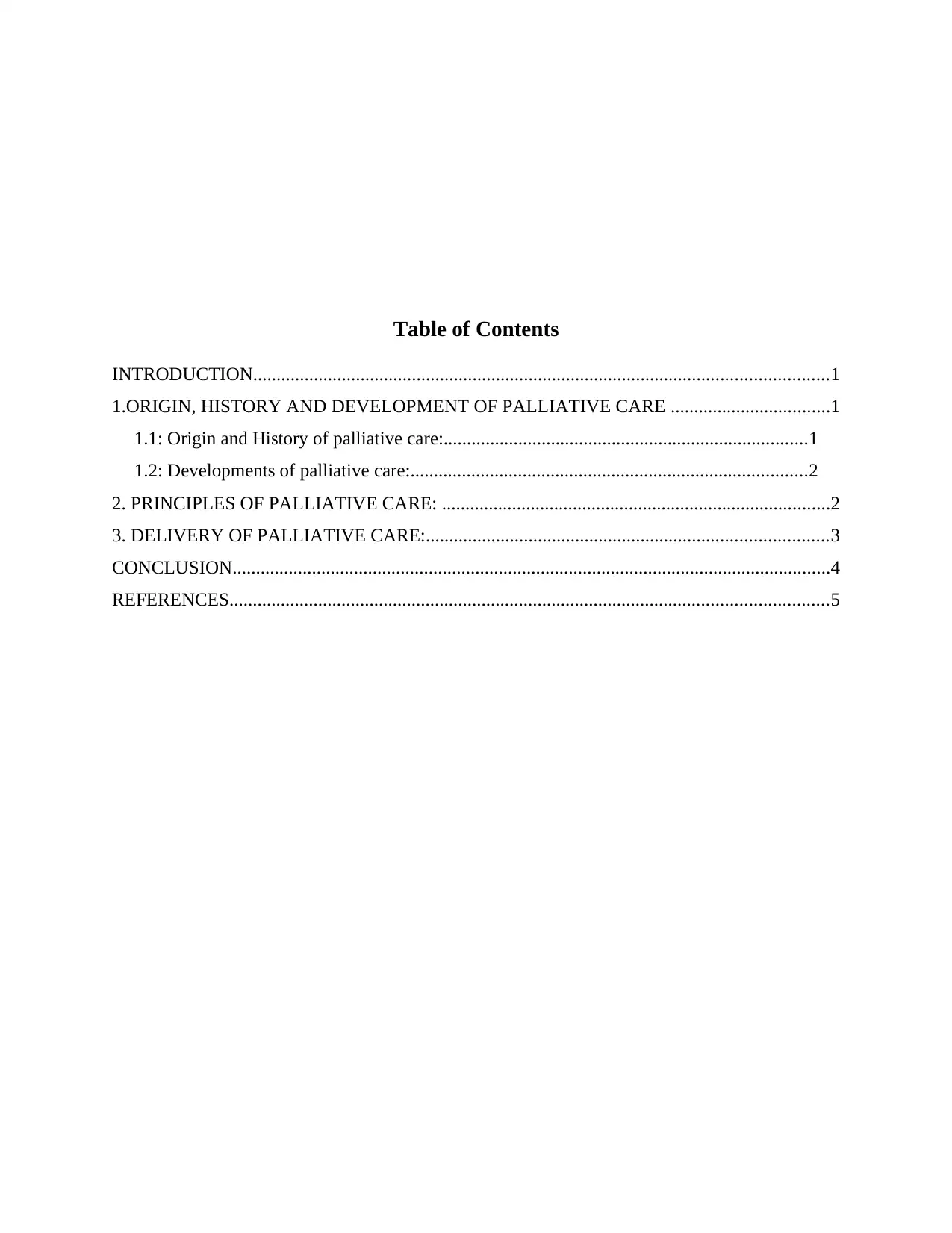
Table of Contents
INTRODUCTION...........................................................................................................................1
1.ORIGIN, HISTORY AND DEVELOPMENT OF PALLIATIVE CARE ..................................1
1.1: Origin and History of palliative care:..............................................................................1
1.2: Developments of palliative care:.....................................................................................2
2. PRINCIPLES OF PALLIATIVE CARE: ...................................................................................2
3. DELIVERY OF PALLIATIVE CARE:......................................................................................3
CONCLUSION................................................................................................................................4
REFERENCES................................................................................................................................5
INTRODUCTION...........................................................................................................................1
1.ORIGIN, HISTORY AND DEVELOPMENT OF PALLIATIVE CARE ..................................1
1.1: Origin and History of palliative care:..............................................................................1
1.2: Developments of palliative care:.....................................................................................2
2. PRINCIPLES OF PALLIATIVE CARE: ...................................................................................2
3. DELIVERY OF PALLIATIVE CARE:......................................................................................3
CONCLUSION................................................................................................................................4
REFERENCES................................................................................................................................5
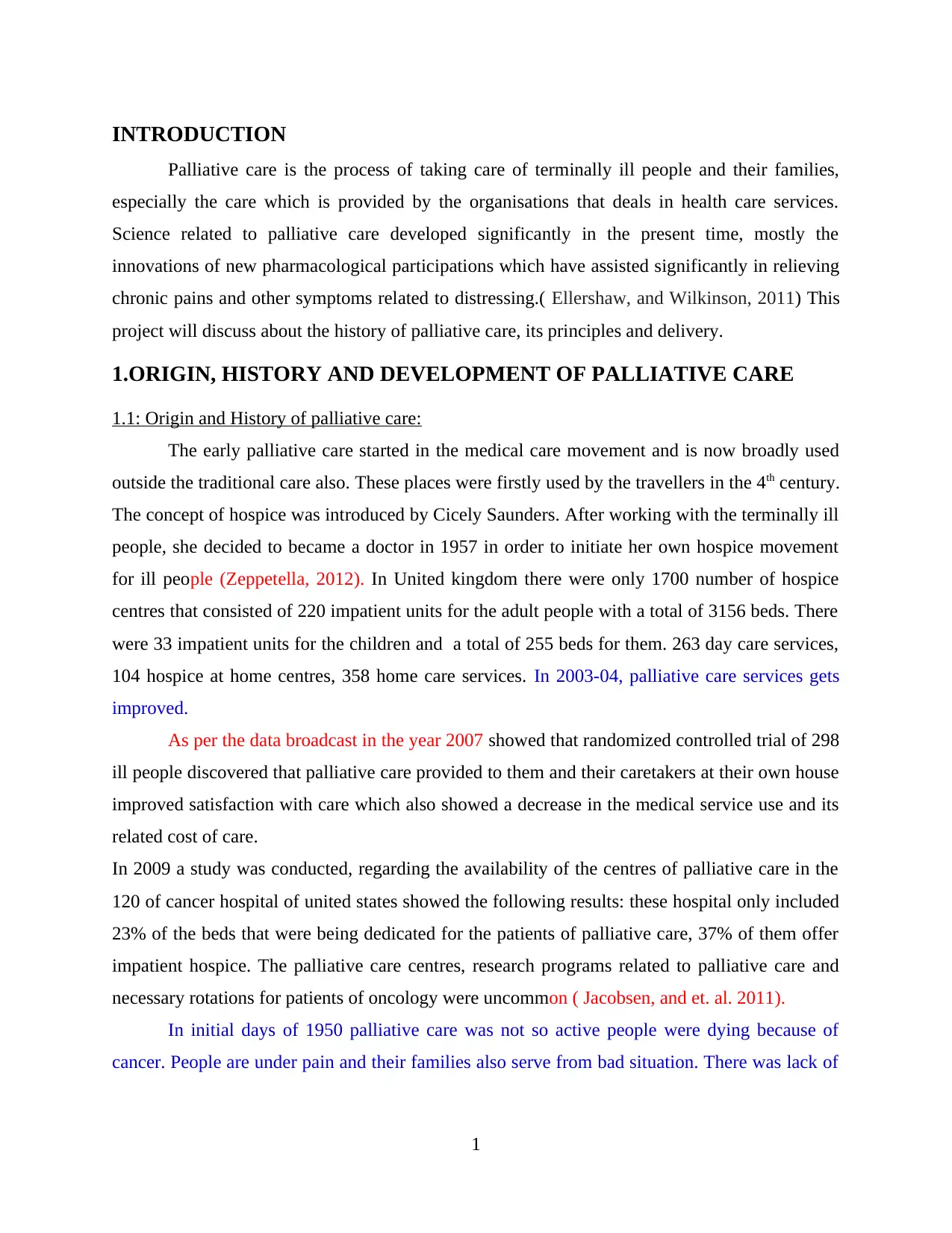
INTRODUCTION
Palliative care is the process of taking care of terminally ill people and their families,
especially the care which is provided by the organisations that deals in health care services.
Science related to palliative care developed significantly in the present time, mostly the
innovations of new pharmacological participations which have assisted significantly in relieving
chronic pains and other symptoms related to distressing.( Ellershaw, and Wilkinson, 2011) This
project will discuss about the history of palliative care, its principles and delivery.
1.ORIGIN, HISTORY AND DEVELOPMENT OF PALLIATIVE CARE
1.1: Origin and History of palliative care:
The early palliative care started in the medical care movement and is now broadly used
outside the traditional care also. These places were firstly used by the travellers in the 4th century.
The concept of hospice was introduced by Cicely Saunders. After working with the terminally ill
people, she decided to became a doctor in 1957 in order to initiate her own hospice movement
for ill people (Zeppetella, 2012). In United kingdom there were only 1700 number of hospice
centres that consisted of 220 impatient units for the adult people with a total of 3156 beds. There
were 33 impatient units for the children and a total of 255 beds for them. 263 day care services,
104 hospice at home centres, 358 home care services. In 2003-04, palliative care services gets
improved.
As per the data broadcast in the year 2007 showed that randomized controlled trial of 298
ill people discovered that palliative care provided to them and their caretakers at their own house
improved satisfaction with care which also showed a decrease in the medical service use and its
related cost of care.
In 2009 a study was conducted, regarding the availability of the centres of palliative care in the
120 of cancer hospital of united states showed the following results: these hospital only included
23% of the beds that were being dedicated for the patients of palliative care, 37% of them offer
impatient hospice. The palliative care centres, research programs related to palliative care and
necessary rotations for patients of oncology were uncommon ( Jacobsen, and et. al. 2011).
In initial days of 1950 palliative care was not so active people were dying because of
cancer. People are under pain and their families also serve from bad situation. There was lack of
1
Palliative care is the process of taking care of terminally ill people and their families,
especially the care which is provided by the organisations that deals in health care services.
Science related to palliative care developed significantly in the present time, mostly the
innovations of new pharmacological participations which have assisted significantly in relieving
chronic pains and other symptoms related to distressing.( Ellershaw, and Wilkinson, 2011) This
project will discuss about the history of palliative care, its principles and delivery.
1.ORIGIN, HISTORY AND DEVELOPMENT OF PALLIATIVE CARE
1.1: Origin and History of palliative care:
The early palliative care started in the medical care movement and is now broadly used
outside the traditional care also. These places were firstly used by the travellers in the 4th century.
The concept of hospice was introduced by Cicely Saunders. After working with the terminally ill
people, she decided to became a doctor in 1957 in order to initiate her own hospice movement
for ill people (Zeppetella, 2012). In United kingdom there were only 1700 number of hospice
centres that consisted of 220 impatient units for the adult people with a total of 3156 beds. There
were 33 impatient units for the children and a total of 255 beds for them. 263 day care services,
104 hospice at home centres, 358 home care services. In 2003-04, palliative care services gets
improved.
As per the data broadcast in the year 2007 showed that randomized controlled trial of 298
ill people discovered that palliative care provided to them and their caretakers at their own house
improved satisfaction with care which also showed a decrease in the medical service use and its
related cost of care.
In 2009 a study was conducted, regarding the availability of the centres of palliative care in the
120 of cancer hospital of united states showed the following results: these hospital only included
23% of the beds that were being dedicated for the patients of palliative care, 37% of them offer
impatient hospice. The palliative care centres, research programs related to palliative care and
necessary rotations for patients of oncology were uncommon ( Jacobsen, and et. al. 2011).
In initial days of 1950 palliative care was not so active people were dying because of
cancer. People are under pain and their families also serve from bad situation. There was lack of
1
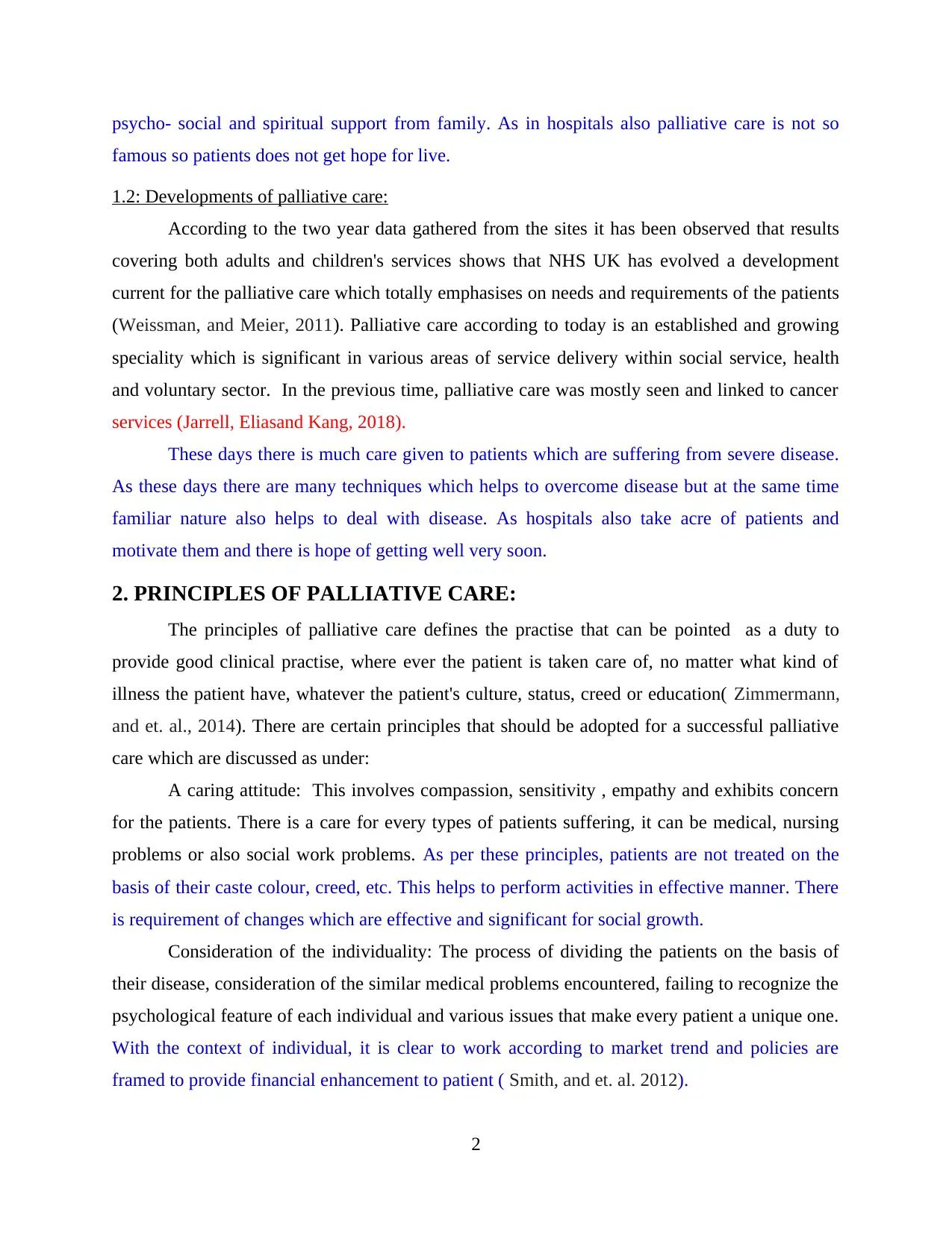
psycho- social and spiritual support from family. As in hospitals also palliative care is not so
famous so patients does not get hope for live.
1.2: Developments of palliative care:
According to the two year data gathered from the sites it has been observed that results
covering both adults and children's services shows that NHS UK has evolved a development
current for the palliative care which totally emphasises on needs and requirements of the patients
(Weissman, and Meier, 2011). Palliative care according to today is an established and growing
speciality which is significant in various areas of service delivery within social service, health
and voluntary sector. In the previous time, palliative care was mostly seen and linked to cancer
services (Jarrell, Eliasand Kang, 2018).
These days there is much care given to patients which are suffering from severe disease.
As these days there are many techniques which helps to overcome disease but at the same time
familiar nature also helps to deal with disease. As hospitals also take acre of patients and
motivate them and there is hope of getting well very soon.
2. PRINCIPLES OF PALLIATIVE CARE:
The principles of palliative care defines the practise that can be pointed as a duty to
provide good clinical practise, where ever the patient is taken care of, no matter what kind of
illness the patient have, whatever the patient's culture, status, creed or education( Zimmermann,
and et. al., 2014). There are certain principles that should be adopted for a successful palliative
care which are discussed as under:
A caring attitude: This involves compassion, sensitivity , empathy and exhibits concern
for the patients. There is a care for every types of patients suffering, it can be medical, nursing
problems or also social work problems. As per these principles, patients are not treated on the
basis of their caste colour, creed, etc. This helps to perform activities in effective manner. There
is requirement of changes which are effective and significant for social growth.
Consideration of the individuality: The process of dividing the patients on the basis of
their disease, consideration of the similar medical problems encountered, failing to recognize the
psychological feature of each individual and various issues that make every patient a unique one.
With the context of individual, it is clear to work according to market trend and policies are
framed to provide financial enhancement to patient ( Smith, and et. al. 2012).
2
famous so patients does not get hope for live.
1.2: Developments of palliative care:
According to the two year data gathered from the sites it has been observed that results
covering both adults and children's services shows that NHS UK has evolved a development
current for the palliative care which totally emphasises on needs and requirements of the patients
(Weissman, and Meier, 2011). Palliative care according to today is an established and growing
speciality which is significant in various areas of service delivery within social service, health
and voluntary sector. In the previous time, palliative care was mostly seen and linked to cancer
services (Jarrell, Eliasand Kang, 2018).
These days there is much care given to patients which are suffering from severe disease.
As these days there are many techniques which helps to overcome disease but at the same time
familiar nature also helps to deal with disease. As hospitals also take acre of patients and
motivate them and there is hope of getting well very soon.
2. PRINCIPLES OF PALLIATIVE CARE:
The principles of palliative care defines the practise that can be pointed as a duty to
provide good clinical practise, where ever the patient is taken care of, no matter what kind of
illness the patient have, whatever the patient's culture, status, creed or education( Zimmermann,
and et. al., 2014). There are certain principles that should be adopted for a successful palliative
care which are discussed as under:
A caring attitude: This involves compassion, sensitivity , empathy and exhibits concern
for the patients. There is a care for every types of patients suffering, it can be medical, nursing
problems or also social work problems. As per these principles, patients are not treated on the
basis of their caste colour, creed, etc. This helps to perform activities in effective manner. There
is requirement of changes which are effective and significant for social growth.
Consideration of the individuality: The process of dividing the patients on the basis of
their disease, consideration of the similar medical problems encountered, failing to recognize the
psychological feature of each individual and various issues that make every patient a unique one.
With the context of individual, it is clear to work according to market trend and policies are
framed to provide financial enhancement to patient ( Smith, and et. al. 2012).
2
Secure Best Marks with AI Grader
Need help grading? Try our AI Grader for instant feedback on your assignments.
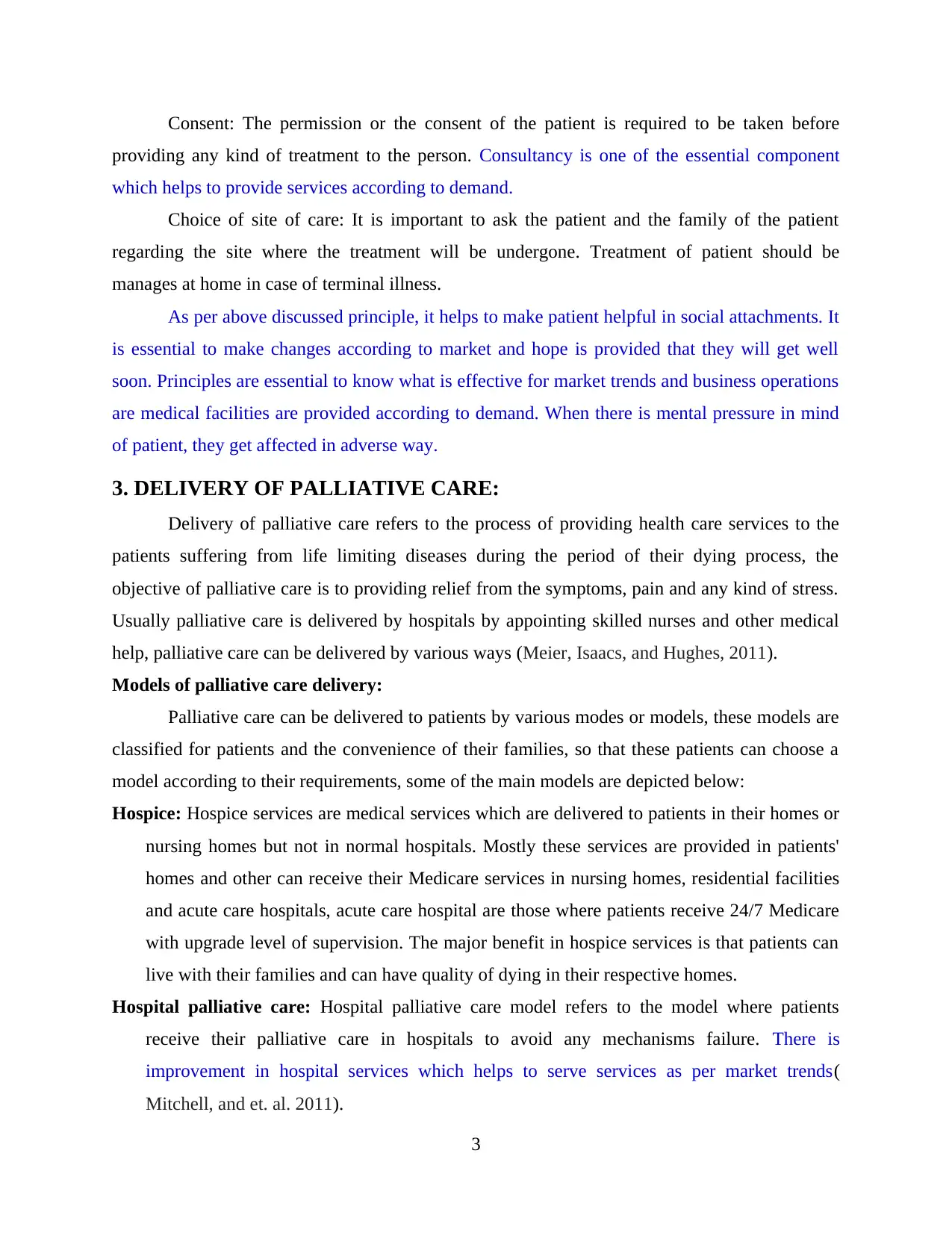
Consent: The permission or the consent of the patient is required to be taken before
providing any kind of treatment to the person. Consultancy is one of the essential component
which helps to provide services according to demand.
Choice of site of care: It is important to ask the patient and the family of the patient
regarding the site where the treatment will be undergone. Treatment of patient should be
manages at home in case of terminal illness.
As per above discussed principle, it helps to make patient helpful in social attachments. It
is essential to make changes according to market and hope is provided that they will get well
soon. Principles are essential to know what is effective for market trends and business operations
are medical facilities are provided according to demand. When there is mental pressure in mind
of patient, they get affected in adverse way.
3. DELIVERY OF PALLIATIVE CARE:
Delivery of palliative care refers to the process of providing health care services to the
patients suffering from life limiting diseases during the period of their dying process, the
objective of palliative care is to providing relief from the symptoms, pain and any kind of stress.
Usually palliative care is delivered by hospitals by appointing skilled nurses and other medical
help, palliative care can be delivered by various ways (Meier, Isaacs, and Hughes, 2011).
Models of palliative care delivery:
Palliative care can be delivered to patients by various modes or models, these models are
classified for patients and the convenience of their families, so that these patients can choose a
model according to their requirements, some of the main models are depicted below:
Hospice: Hospice services are medical services which are delivered to patients in their homes or
nursing homes but not in normal hospitals. Mostly these services are provided in patients'
homes and other can receive their Medicare services in nursing homes, residential facilities
and acute care hospitals, acute care hospital are those where patients receive 24/7 Medicare
with upgrade level of supervision. The major benefit in hospice services is that patients can
live with their families and can have quality of dying in their respective homes.
Hospital palliative care: Hospital palliative care model refers to the model where patients
receive their palliative care in hospitals to avoid any mechanisms failure. There is
improvement in hospital services which helps to serve services as per market trends(
Mitchell, and et. al. 2011).
3
providing any kind of treatment to the person. Consultancy is one of the essential component
which helps to provide services according to demand.
Choice of site of care: It is important to ask the patient and the family of the patient
regarding the site where the treatment will be undergone. Treatment of patient should be
manages at home in case of terminal illness.
As per above discussed principle, it helps to make patient helpful in social attachments. It
is essential to make changes according to market and hope is provided that they will get well
soon. Principles are essential to know what is effective for market trends and business operations
are medical facilities are provided according to demand. When there is mental pressure in mind
of patient, they get affected in adverse way.
3. DELIVERY OF PALLIATIVE CARE:
Delivery of palliative care refers to the process of providing health care services to the
patients suffering from life limiting diseases during the period of their dying process, the
objective of palliative care is to providing relief from the symptoms, pain and any kind of stress.
Usually palliative care is delivered by hospitals by appointing skilled nurses and other medical
help, palliative care can be delivered by various ways (Meier, Isaacs, and Hughes, 2011).
Models of palliative care delivery:
Palliative care can be delivered to patients by various modes or models, these models are
classified for patients and the convenience of their families, so that these patients can choose a
model according to their requirements, some of the main models are depicted below:
Hospice: Hospice services are medical services which are delivered to patients in their homes or
nursing homes but not in normal hospitals. Mostly these services are provided in patients'
homes and other can receive their Medicare services in nursing homes, residential facilities
and acute care hospitals, acute care hospital are those where patients receive 24/7 Medicare
with upgrade level of supervision. The major benefit in hospice services is that patients can
live with their families and can have quality of dying in their respective homes.
Hospital palliative care: Hospital palliative care model refers to the model where patients
receive their palliative care in hospitals to avoid any mechanisms failure. There is
improvement in hospital services which helps to serve services as per market trends(
Mitchell, and et. al. 2011).
3
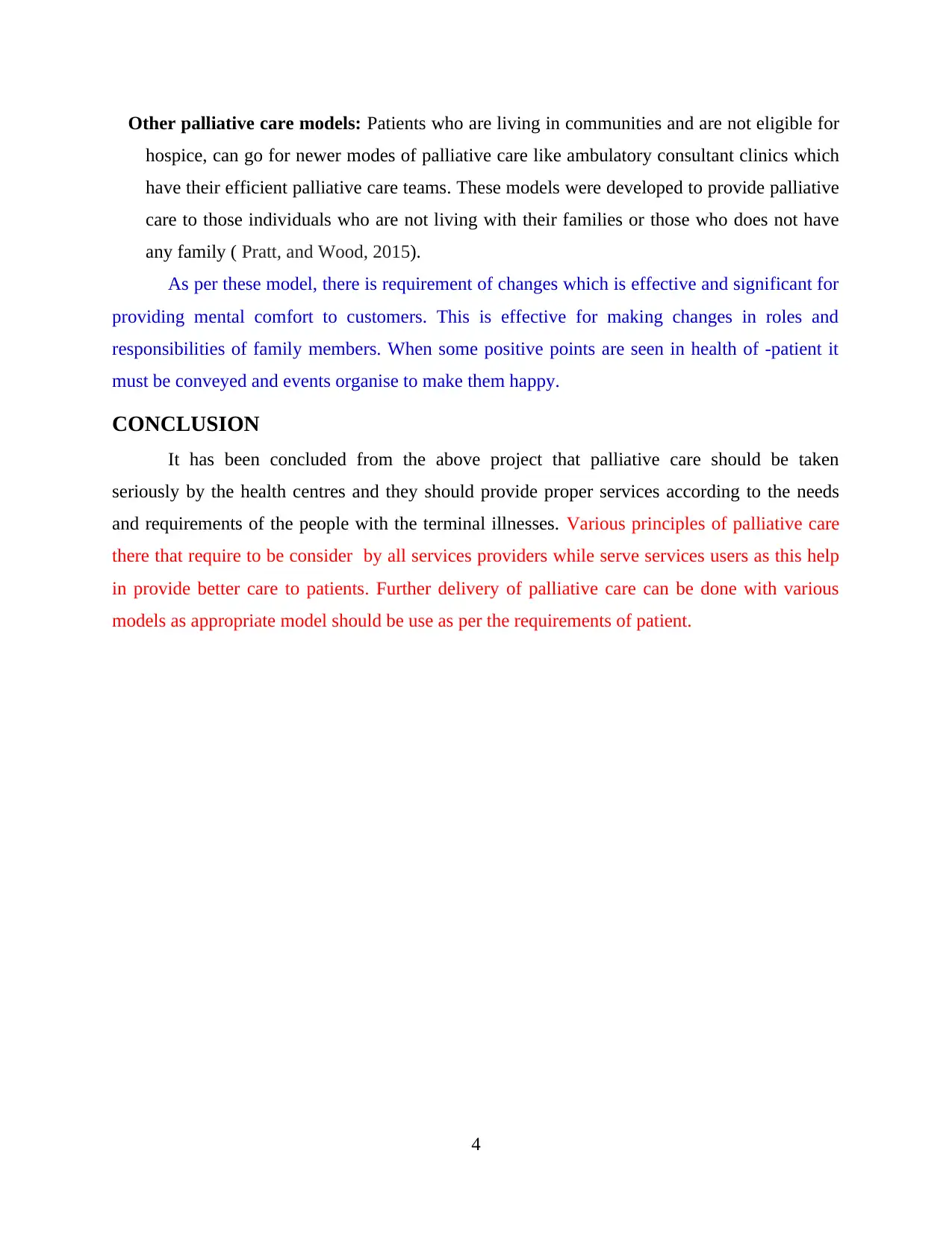
Other palliative care models: Patients who are living in communities and are not eligible for
hospice, can go for newer modes of palliative care like ambulatory consultant clinics which
have their efficient palliative care teams. These models were developed to provide palliative
care to those individuals who are not living with their families or those who does not have
any family ( Pratt, and Wood, 2015).
As per these model, there is requirement of changes which is effective and significant for
providing mental comfort to customers. This is effective for making changes in roles and
responsibilities of family members. When some positive points are seen in health of -patient it
must be conveyed and events organise to make them happy.
CONCLUSION
It has been concluded from the above project that palliative care should be taken
seriously by the health centres and they should provide proper services according to the needs
and requirements of the people with the terminal illnesses. Various principles of palliative care
there that require to be consider by all services providers while serve services users as this help
in provide better care to patients. Further delivery of palliative care can be done with various
models as appropriate model should be use as per the requirements of patient.
4
hospice, can go for newer modes of palliative care like ambulatory consultant clinics which
have their efficient palliative care teams. These models were developed to provide palliative
care to those individuals who are not living with their families or those who does not have
any family ( Pratt, and Wood, 2015).
As per these model, there is requirement of changes which is effective and significant for
providing mental comfort to customers. This is effective for making changes in roles and
responsibilities of family members. When some positive points are seen in health of -patient it
must be conveyed and events organise to make them happy.
CONCLUSION
It has been concluded from the above project that palliative care should be taken
seriously by the health centres and they should provide proper services according to the needs
and requirements of the people with the terminal illnesses. Various principles of palliative care
there that require to be consider by all services providers while serve services users as this help
in provide better care to patients. Further delivery of palliative care can be done with various
models as appropriate model should be use as per the requirements of patient.
4
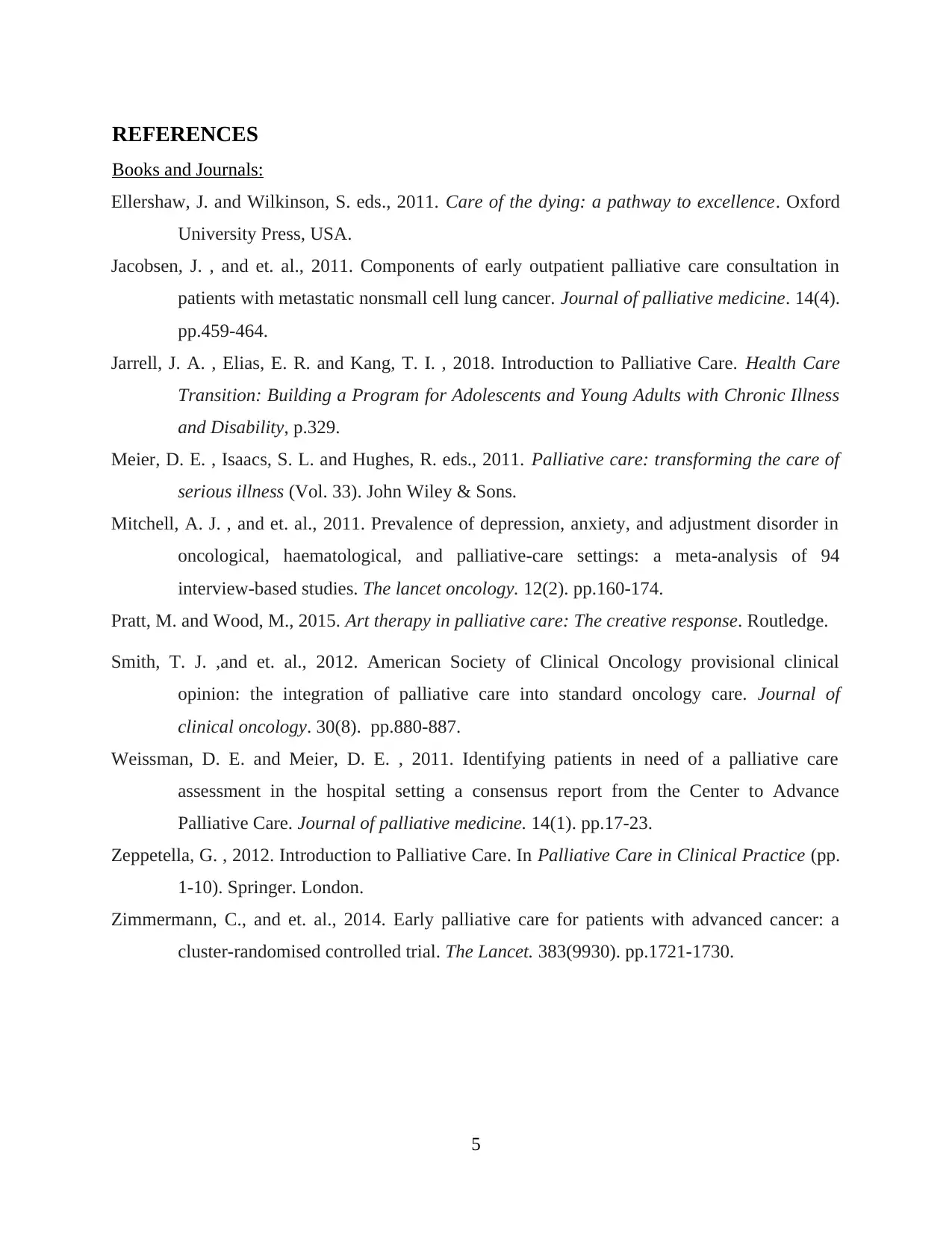
REFERENCES
Books and Journals:
Ellershaw, J. and Wilkinson, S. eds., 2011. Care of the dying: a pathway to excellence. Oxford
University Press, USA.
Jacobsen, J. , and et. al., 2011. Components of early outpatient palliative care consultation in
patients with metastatic nonsmall cell lung cancer. Journal of palliative medicine. 14(4).
pp.459-464.
Jarrell, J. A. , Elias, E. R. and Kang, T. I. , 2018. Introduction to Palliative Care. Health Care
Transition: Building a Program for Adolescents and Young Adults with Chronic Illness
and Disability, p.329.
Meier, D. E. , Isaacs, S. L. and Hughes, R. eds., 2011. Palliative care: transforming the care of
serious illness (Vol. 33). John Wiley & Sons.
Mitchell, A. J. , and et. al., 2011. Prevalence of depression, anxiety, and adjustment disorder in
oncological, haematological, and palliative-care settings: a meta-analysis of 94
interview-based studies. The lancet oncology. 12(2). pp.160-174.
Pratt, M. and Wood, M., 2015. Art therapy in palliative care: The creative response. Routledge.
Smith, T. J. ,and et. al., 2012. American Society of Clinical Oncology provisional clinical
opinion: the integration of palliative care into standard oncology care. Journal of
clinical oncology. 30(8). pp.880-887.
Weissman, D. E. and Meier, D. E. , 2011. Identifying patients in need of a palliative care
assessment in the hospital setting a consensus report from the Center to Advance
Palliative Care. Journal of palliative medicine. 14(1). pp.17-23.
Zeppetella, G. , 2012. Introduction to Palliative Care. In Palliative Care in Clinical Practice (pp.
1-10). Springer. London.
Zimmermann, C., and et. al., 2014. Early palliative care for patients with advanced cancer: a
cluster-randomised controlled trial. The Lancet. 383(9930). pp.1721-1730.
5
Books and Journals:
Ellershaw, J. and Wilkinson, S. eds., 2011. Care of the dying: a pathway to excellence. Oxford
University Press, USA.
Jacobsen, J. , and et. al., 2011. Components of early outpatient palliative care consultation in
patients with metastatic nonsmall cell lung cancer. Journal of palliative medicine. 14(4).
pp.459-464.
Jarrell, J. A. , Elias, E. R. and Kang, T. I. , 2018. Introduction to Palliative Care. Health Care
Transition: Building a Program for Adolescents and Young Adults with Chronic Illness
and Disability, p.329.
Meier, D. E. , Isaacs, S. L. and Hughes, R. eds., 2011. Palliative care: transforming the care of
serious illness (Vol. 33). John Wiley & Sons.
Mitchell, A. J. , and et. al., 2011. Prevalence of depression, anxiety, and adjustment disorder in
oncological, haematological, and palliative-care settings: a meta-analysis of 94
interview-based studies. The lancet oncology. 12(2). pp.160-174.
Pratt, M. and Wood, M., 2015. Art therapy in palliative care: The creative response. Routledge.
Smith, T. J. ,and et. al., 2012. American Society of Clinical Oncology provisional clinical
opinion: the integration of palliative care into standard oncology care. Journal of
clinical oncology. 30(8). pp.880-887.
Weissman, D. E. and Meier, D. E. , 2011. Identifying patients in need of a palliative care
assessment in the hospital setting a consensus report from the Center to Advance
Palliative Care. Journal of palliative medicine. 14(1). pp.17-23.
Zeppetella, G. , 2012. Introduction to Palliative Care. In Palliative Care in Clinical Practice (pp.
1-10). Springer. London.
Zimmermann, C., and et. al., 2014. Early palliative care for patients with advanced cancer: a
cluster-randomised controlled trial. The Lancet. 383(9930). pp.1721-1730.
5
1 out of 7
Related Documents
Your All-in-One AI-Powered Toolkit for Academic Success.
+13062052269
info@desklib.com
Available 24*7 on WhatsApp / Email
![[object Object]](/_next/static/media/star-bottom.7253800d.svg)
Unlock your academic potential
© 2024 | Zucol Services PVT LTD | All rights reserved.





